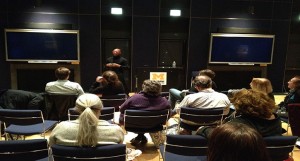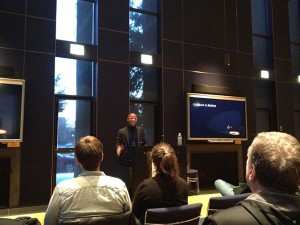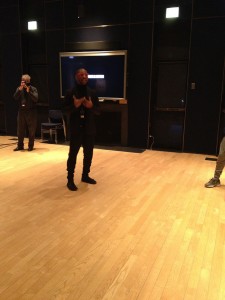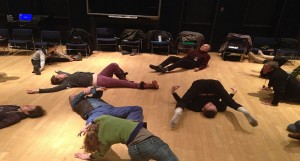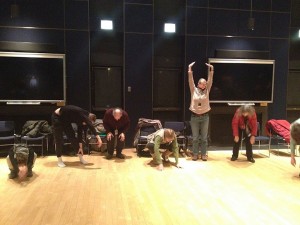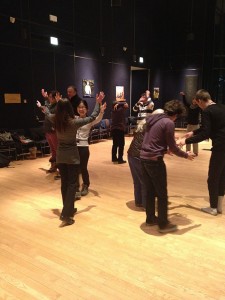UMS Night School: Curious About Dance – Session 4 Recap
Editor’s note: This post is a part of a series of by U-M student and UMS intern Hillary Kooistra, who’s covering our free UMS Night School: Curious About Dance workshop series.
Anything You Do Will Be Perfect
Welcome back, Night Schoolers! I hope everyone enjoyed their time off! The sun has been shining all week and it was certainly shining in the Alumni Center on Monday night. We were joined by Kyle Abraham, Founder/Artistic Director of Abraham.In.Motion (AIM): the company that will grace the Power Center stage this coming Friday and Saturday. Also with us was Matthew Baker, AIM choreographic associate/dancer, graduate of Western Michigan University, and Ann Arbor native. These two incredible artists invited us into the world of Abraham.In.Motion by demonstrating and talking about the company’s work, as well as allowing us to embody a bit of their choreographic process. Kyle, a MacArthur Award recipient and fascinating thinker/speaker/mover, confirmed an idea we have returned to each Night School session: dance is a thoughtful, collaborative and process-driven art form.
Kyle kicked off our session by showing us video clips of some of his work: Live! The Realest MC, Pavement, and the two works that his company will perform on Friday and Saturday: The Watershed and When the Wolves Came In. As we watched these intersections between stunning movement and innovative stage design, Kyle described the thought, research and collaboration behind the dances. We were then able to make informed, conceptual observations about each work while enjoying some incredible aesthetics. No wonder this man won a genius grant!
Kyle Abraham talks about his process before showing us clips of some of his dances.
After giving us a chance to see and hear about his dances, Kyle introduced us to the way he works with his company and let us experience his choreographic process with our own bodies. He led us through a few creative activities he uses to establish movement and choreography in collaboration with his dancers. Kyle is not one to simply enter a rehearsal with set material for his company to learn and replicate; his process-driven approach to choreography pays careful attention to the potential contributions of each individual body and mind in the room.
Kyle explains some of the intentions behind his process to a curious Night School cohort.
With these ideas in mind, we plunged into some AIM-motivated movement invention and exploration. First, we learned and practiced a simple arm gesture phrase (from The Quiet Dance, another work in his company’s repertoire).We executed this upper body sequence as we learned it, while letting our legs do whatever they wanted. We also explored a way to compose our own phrases by responding to “Action Words.” As Kyle (and fellow Night School Student Fred) prompted us to slice, jump, slide, squish, wiggle, and dive, we travelled across the room with our own sequences of movements and rhythms.
Night School students experience Kyle’s choreographic process: creating our own leg movements to accompany a set of arm gestures and travelling across the room in response to Action Words.
Kyle explained that the movement he and his dancers generate out of such tasks often becomes the starting point for phrases in his repertory works. In a third exercise dubbed “Catch What You Can,” he and Matthew demonstrated how one seed idea can blossom into a longer, lasting sequence. Kyle grooved to some music while Matthew followed behind him, trying to grasp as much movement as he could. Then Kyle instructed Matthew with prompts such as “left arm and leg chug back,” and “figure eight to the right,” as well as names of moves that seemed to have a significance within the company, such as “Classic.” Regardless of the prompt’s origin, Matthew remained on the same page as Kyle the entire time, and breezed about the floor as he constructed his phrase. The result was amazing. From Kyle’s few moments of visual and verbal cues, Matthew danced an entire phrase of movement without stopping to think once: leaving us asking, “Did that just happen?”
Abraham.In.Motion dancer Matthew Baker develops a sequence of movement by “catching what he can” of Kyle’s visual and verbal cues
Once we picked our jaws off the ground and Matthew got a chance to catch his breath, we sat back down for a conversation with the two artists. Kyle provided generous answers to our questions about his company and process, sharing insights about the shifting roles of dancers and choreographers, the value of time in choreographic development and honesty in performance, and the approach to working with new bodies while creating work on others. I must be getting early onset nostalgia as we approach our final Night School next week, because I could not help but recall all the lessons we’ve learned this semester as I heard Kyle speak about his work. Remember the exercise we did with Martine a couple of weeks back, where we had to remember our partner’s gestures as they told us “something nobody knew”? I thought of that session throughout Kyle’s “Catch What You Can.” How Charles helped us alter gestures so they would fit the two-dimensionality required by labanotation? Very similar to how Kyle revealed he will develop a gesture until it has traces of its origin but breathes a new life.
If there’s one thing I think we’ve all learned through Night School this year, it’s that there are many, many entryways into making, viewing, and discussing dance. We’ve had the privilege of unfolding these multiple layers throughout the weeks: questioning why plastic bags float in the air, how people walk on walls, or where Kyle Abraham finds his musical inspiration. But more time for reflection next week. This week, we have a marathon of events related to Kyle’s residency to look forward to! Remember, Friday and Saturday will showcase two different programs, so why not buy two sets of tickets and camp out at the Power Center this weekend? You can even stay an extra night and be fed bagels on Sunday at the first ever UMS Brunch Download Conversation. Hope to see everyone this weekend, and at our LAST session/graduation next Monday night! In addition to thinking about the UMS dance season still to come, we will be celebrating with our Adventure Card raffle drawing, Perfect Attendance Awards, and of course, some food and drinks. So don’t miss out! No cap and gown necessary, just your presence and energy.
Upcoming Events:
Abraham.In.Motion Performances, Mar. 13-14, 8pm, Power Center (TICKET REQUIRED)
Related:
Mar. 13: Opening Night Q&A: Abraham.In.Motion, Power Center, post-performance (TICKET REQUIRED)
Mar. 14: You Can Dance: Abraham.In.Motion, Ann Arbor YMCA, 1:30-3pm (FREE – SIGN-UP REQUIRED, BEGINS AT 12:45PM, FIRST COME FIRST SERVE)
Mar. 14: Closing Night Q&A: Abraham.In.Motion, Power Center, post-performance (TICKET REQUIRED)
Mar. 15: Brunch Download with Kyle Abraham, U-M Alumni Center, 11am (FREE)
Session 4 Resources:
Kyle Abraham/Abraham.In.Motion, Live! The Realest MC Promotional Video
Kyle Abraham/Abraham.In.Motion, Pavement Promotional Video
Kyle Abraham/Abraham.In.Motion, The Gettin’ Promotional Video
UMS Night School: Curious About Dance – Session 2 Recap
Editor’s note: This post is a part of a series of by U-M student and UMS intern Hillary Kooistra, who’s covering our free UMS Night School: Curious About Dance workshop series.
It’s Just So…French
We might be facing sub-zero temperatures outside this week, but things were definitely heating up in the U-M Alumni Center on Monday night. We began our second Night School session with a stimulating conversation about Compagnie Non Nova’s Afternoon of a Foehn, then launched into a movement workshop led by newly Chicago-based solo contemporary artist Anna Martine Whitehead. Gestures played a key role in Monday’s session; in both our post-show reflection and Martine’s movement workshop, we found ways to make meaning through the creation, manipulation, and reimagination of repeated motions.
To begin the session, Clare reintroduced our Night School ritual: saying our names while performing a gesture. This time, as a way to kick off the conversation about Compagnie Non Nova, we recalled and produced gestures from the performance. Afternoon of a Foehn runs through next weekend, so those of us who have not yet seen it were instructed to amplify someone else’s gesture. The result? A highly creative game of movement telephone that had us moving in, out, and through our circle in response to one another’s memories of the performance.
We then shared the significance of the gestures we picked, and identified themes and concepts that stuck with us as we watched the performance. What makes a strong visual in performance? How do the rules established in performance alter our expectations of what is to come? How can the performance space change throughout the narrative, and how can it change us? These are only some of the questions that came up as we dissected our own interpretations of the captivating piece of experimental theatre (/dance/ballet/performance art…as we discussed, the category in which it falls is really up to interpretation).
We also landed on a discussion about the conventions of French performance, and how American audiences identify the work produced by European companies as well…European. The hierarchies of performers, sense of pride in claiming a space, and abstraction of narrative are some of the aspects we landed on as, to quote Clare, “just so…French.” For those who plan to head to Skyline High School this weekend, I’d be curious to hear if these concepts stick out to you as you watch the performance.
Warming up for a movement workshop by exploring negative space and interacting with others.
Our discussion of the many ways to approach and interpret Afternoon of a Foehn served as a perfect segway to Martine’s workshop, which centered around the choreographic approach of rethinking movement. She associated this process with Queer Dance, which offers alternative ways to think about gender and sexuality, critique the normal, and imagine other ways to be in the world. Martine will demonstrate this mode of thinking in this week’s performance of Confetti Sunrise, which features the work of Martine and four other queer artists. The workshop served to prepare us for this show, as well as for this weekend’s performance by the Trisha Brown Dance Company.
Throughout the half hour we spent stretching, speaking, moving, and listening, Martine invited us to think: How can gesture make meaning? How can we embellish it, and do it so much that it creates own score? She invited us to act on our instinct, focusing on the concepts of compulsion and desire.
Indulging in stretches during Anna Martine Whitehead’s movement session!
We ended the session in conversation with a partner, during which words were not the primary conversational agents. Responding to the prompt “tell me something that nobody knows,” we performed for our partners a series of gestures that they recalled and repeated back to us. We then manipulated the gestures that we grabbed from our partners (embellished, amplified, repeated, took to a different level…) and created a repeatable sequence–known in dance as a phrase. The exercise encouraged us to think about movement, maybe first as a substitute for words, but then as its own entity whose meaning might veer away from the choreographer’s original narrative.
My fantastic partner, Howard, tells me something that nobody knows using only gestures.
Howard recalls the gestures I conveyed to tell him something that nobody knows.
I was happy to think about this exercise not only from a Queer Dance perspective, but within the context of Trisha Brown. I interned for the company this past summer through UMS’s 21st Century Artist Internship Program, and I was lucky enough to take composition/improvisation classes with Associate Artistic Director Diane Madden while I was there. In class, Diane introduced to me Trisha’s choreographic method of “throwing and catching” movement: Trisha often performed gestures or longer series of movement for her dancers, then asked them to repeat them back to her without ruminating on what they saw. The dancers’ interpretations of her movements ultimately inspired much of her choreography. As I explored this process over the summer, I developed an awareness of how I interpreted movement and how my own movement resonated with others. I was excited to return to this way of working in Night School, and to draw ties between Trisha’s historic work and the innovative contemporary work of Queer Dance artists.
Silent conversations with partners–using gestures to convey meaning.
Speaking of Trisha Brown, we have quite the marathon of dance ahead of us in Ann Arbor this week! Compagnie Non Nova, Confetti Sunrise, Trisha Brown, Dance on Camera…we can have a quadruple bill if we really want to! Remember, if you go to more than one performance this weekend, you are eligible for double stars on your UMS Card. More stars, more dance, more fun.
Next Monday, we will be joined by U-M Associate Professor of Dance Amy Chavasse for our discussion of Confetti Sunrise and Trisha Brown. Then we get to raise a cupcake to Clare in celebration of her new book! She and Jim will be in conversation about Dancers as Diplomats: American Choreography in Cultural Exchange for the latter half of our session, so come hungry for treats and lots of dance talk! (Photocopies of Clare’s first two chapters can be found in our Night School folders, if anyone wants to complete a little pre-reading.)
Events This Weekend:
- Compagnie Non Nova, Afternoon of a Foehn, Feb. 14-21, various times, Skyline High School. TICKET REQUIRED
- Confetti Sunrise, Feb. 18-19, 7:30pm, U-M Duderstadt Center, Video Studio (FREE BUT LIMITED SEATING, FIRST COME FIRST SERVE)
- Dance on Camera Festival, Feb. 21-22, 6pm, U-M Museum of Art, FREE
- Trisha Brown Dance Company Performances, Feb. 21-22, 8pm, Power Center. TICKET REQUIRED
- Related Events:
- Feb. 21: You Can Dance: Trisha Brown Dance Company, Ann Arbor YMCA, 10:45am-12:15pm (SIGN-UP REQUIRED, BEGINS AT 10AM, FIRST COME FIRST SERVE)
- Feb. 21: Tune In: Trisha Brown Dance Company, Power Center Lobby, 7:30-7:45pm (TICKET REQUIRED)
- Feb 21: Opening Night Q&A: Trisha Brown Dance Company, Power Center, post-performance (TICKET REQUIRED)
- Related Events:
Session 2 Resources and Readings:
Dancers as Diplomats by Clare Croft
Introduction
Chapter 2


